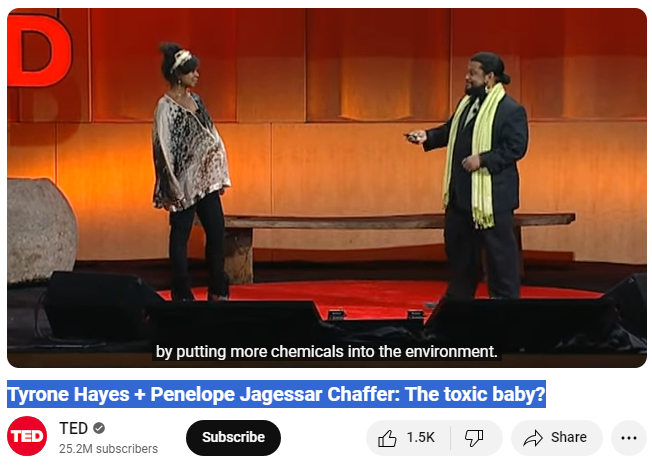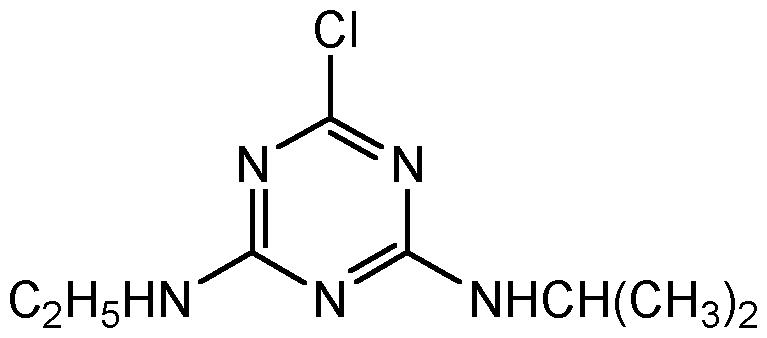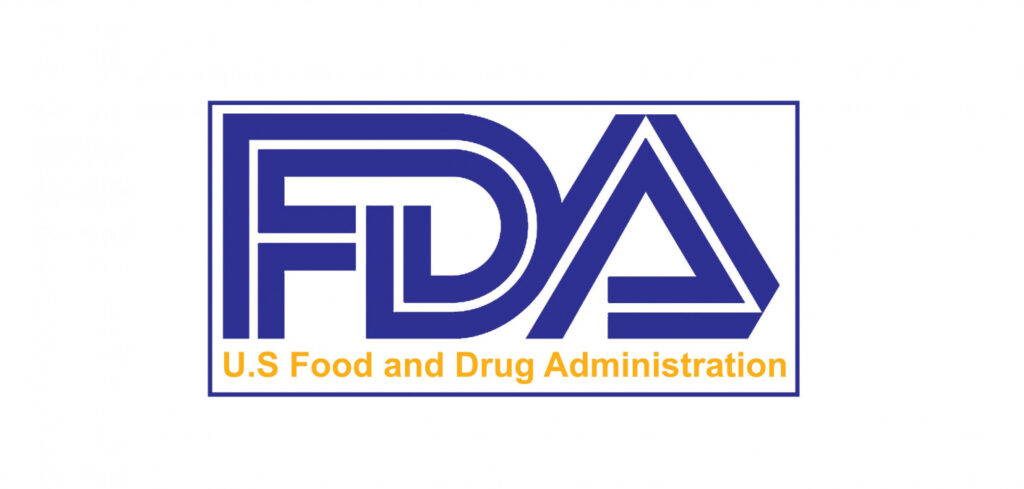American women today have 30,000 to 50,000 chemicals in their bodies that their grandparents did not have. Many of these chemicals have been linked to the rapidly rising incidence of chronic childhood diseases.
If common chemicals harm frogs and rats, what are they doing to your children?
This article was published on The Defender—Children’s Health Defense News & Views Website on October 18, 2024
The TED Talk (titled Tyrone Hayes + Penelope Jagessar Chaffer: The toxic baby?) features Penelope Jagessar Chaffer, director of the documentary film “Toxic Baby,” and Tyrone Hayes, Ph.D., a professor of integrative biology at the University of California, who has dedicated most of his career to studying the health effects of the herbicide atrazine.
According to Chaffer, the average American woman today has 30,000 to 50,000 chemicals in her body that her grandparents did not have. Many of these chemicals have been linked to the rapidly rising incidence of chronic childhood diseases.
Statistics reveal our children are at grave risk
In her talk, Chaffer cites the following statistics, which are likely higher today, since this talk was given in 2010:
- In the United Kingdom (U.K.), the incidence of childhood leukemia rose by 20% in one generation.
- In Canada, the prevalence of asthma increased by 400% in 20 years; 1 in 10 children is now diagnosed with asthma.
In the U.S., childhood cancers have seen a similar rise as that of childhood leukemia in the U.K. Autism spectrum disorder has also increased by 600% in the past 20 years; the incidence of autism rose by 57% between 2002 and 2006 alone.
In the Netherlands, Rotterdam has seen a 400% increase in genital birth defects.
Obesity and juvenile diabetes have also skyrocketed, and while a high-sugar diet likely bears the brunt of the blame, there’s every reason to suspect that endocrine-disrupting chemicals (EDCs) —many of which enter our system via processed foods—add to the metabolic dysfunction we now see.
Atrazine is a common water contaminant
Atrazine is the second most commonly used herbicide in the U.S., and the most commonly found herbicide in U.S. ground, rain and drinking water. It’s widely used to combat weeds on golf courses, residential lawns and in commercial agriculture. For example, it’s used on half of all corn grown in the U.S.
Atrazine was approved for use in 1958, and its long history of use is often cited as “proof” of its safety. However, history tells us toxic chemicals can remain in use for a very long time before appropriate action is taken against them.
The European Union (EU) banned atrazine in 2005, as suspicions of health problems and environmental damage mounted.
In the U.S., atrazine use continued unabated, in large part due to powerful lobbying efforts by Syngenta. In 2005, Syngenta spent $250,000 on lobbying in Minnesota alone, to keep atrazine sales going.
Hayes’ involvement with atrazine began when Novartis (which later became Syngenta) hired him to investigate the effects of atrazine on amphibians. His research showed that atrazine, even at the very low level of 0.1 part per billion (ppb), causes hermaphroditism in frogs.

Atrazine’s effects on frogs may indicate effects on children
It turns males into egg-laying females by inducing an enzyme called aromatase, which causes the overproduction of estrogen. Even more disturbing, it produced male frogs with TWO sets of each sex organ, meaning two sets of testes and two sets of ovaries.
The voice box in male frogs also did not develop properly, indicating that testosterone was not being produced at appropriate levels for development.
Normally, the male testes make testosterone. Atrazine “turns on” the enzyme aromatase, which converts testosterone into estrogen. As a result, the male frogs lose their testosterone; they’re essentially chemically castrated and are feminized as a result of the excessive estrogen being produced.
Testing has revealed that 85% of male smallmouth bass in 19 American wildlife refuges are carrying eggs. Like amphibians, smallmouth bass are known to be very sensitive to pollutants, hence, researchers use them as an “indicator species” when evaluating the ecological impact of environmental pollutants.
In the case of water pollution with EDCs, the situation does indeed appear to be severe. The lowest incidence of feminization or intersex in the wildlife refuges tested was 60%. The highest was 100%.
From frogs to babies
On the whole, Hayes’ research raises serious questions about human health effects.
Atrazine may be involved in the development of breast cancer, for example, since many breast cancers are triggered by the overproduction of estrogen and are regulated by the enzyme aromatase.
As noted by Hayes, aromatase is so important in the development of breast cancer, the cancer drug Letrozole works by blocking aromatase, which in turn blocks estrogen production. Ironically, Letrozole is also produced by Syngenta, the same company that brought us atrazine.
It should be obvious to anyone that “an ounce of prevention is worth more than a pound of cure,” but instead of addressing rising breast cancer rates by preventing exposure to the aromatase-inducing chemical (atrazine), Syngenta is allowed to make large profits by selling an aromatase-blocking treatment (Letrozole) instead.
According to Hayes, research published by an international team of scientists, including himself, shows atrazine causes sexual reproductive problems in a wide range of animals, including mammals, birds and fish, not just amphibians, which was the focus of his earlier research.
One study also linked atrazine exposure in utero to impaired sexual development in young boys, causing genital deformations, including microphallus (micropenis).
The evidence also suggests atrazine exposure contributes to a number of different cancers, specifically ovarian cancer, non-Hodgkin’s lymphoma, hairy-cell leukemia and thyroid cancer.
Elevated concentrations of atrazine in drinking water have been associated with birth defects, including abdominal defects, gastroschisis (in which the baby’s intestines stick outside of the baby’s body) and others.

Syngenta suppressed research showing atrazine risks
In another interview (below), Hayes revealed that Syngenta initially tried to convince him to manipulate and misrepresent the data. When he refused, the company retaliated by refusing to grant him permission to publish the results. He also was not allowed to discuss the data outside a closed panel of Syngenta employees.
After cutting ties with Syngenta in 2000, he obtained independent funding to repeat the research, which was subsequently published.
Atrazine causes fertility problems
According to Hayes, atrazine:
- Induces breast cancer in females.
- Induces prostate cancer in males.
- Male fertility is reduced by as much as 50%, as the chemical produces holes in the testicular tissue. This has been shown in fish, amphibians, reptiles and mammals.
- Retards mammary (breast) development in females.
- Induces abortion in female rodents.
Peer-reviewed studies also support the notion that atrazine poses similar threats to humans. Among female rodents exposed to atrazine, spontaneous abortions are common.
And when abortion does not occur, the surviving male pups have higher rates of prostate disease —they’re essentially born with an old man’s disease — and female pups have impaired mammary development.
When the surviving pups go on to reproduce, the following generation suffers impaired growth and development because the mother is unable to make enough milk due to impaired mammary development.
Considering these generational effects, those of us who are exposed to this chemical today are affecting not only the health of our own children (predisposing them to obesity, diabetes, breast cancer and more) but also the health of our grandchildren’s grandchildren.
These chemicals not only cross the placenta, entering the baby while still in the womb, they also pass through breast milk. So whatever the mother is exposed to, the baby gets as well, even after they’re born.
“We are, in effect, polluting our children,” Chaffer says.
Other endocrine-disrupting chemicals
Chaffer also touches on other hormone-disrupting chemicals, such as BPA, a chemical so well-known for its estrogenic effects that it was even considered for use in synthetic hormone replacement therapy at one point. Despite this, and despite research showing it leaches from the plastic, BPA was used in hard plastic baby bottles and sippy cups.

In 2010, the EU banned BPA in infant products such as these, recognizing that dosing infants with estrogen is a bad idea. Around the same time, Canada declared BPA a toxic substance and use of it in baby products has been banned there as well.
The U.S. finally followed suit in 2012, banning BPA in baby bottles and sippy cups. However, the U.S. Food and Drug Administration (FDA) went on to reassert the safety of BPA in 2014, even when it comes into contact with, and migrates into food.
Based on the evidence, it is beyond irrational to conclude that this verdict is anything but the result of lobbying and the revolving door between the FDA and the chemical industry. Hence, BPA is still widely used in hard plastics, can liners, paper receipts and a wide variety of other plastic goods, so exposure continues to be widespread.
EDCs such as BPA and BPS, dioxins, organophosphate and organochlorine pesticides, PCBs, phthalates and others, have been linked to:
- IQ loss and associated intellectual disability.
- Autism.
- Attention-deficit hyperactivity disorder (ADHD).
- Childhood and adult obesity.
- Prostate and breast cancers.
- Adult diabetes.
- Cryptorchidism (undescended testicle).
- Male infertility.
- Mortality associated with reduced testosterone.
- Male and female reproductive dysfunctions.
- Cardiopulmonary disease.
- Immune dysregulation.
EPA reassesses atrazine
Syngenta and other atrazine proponents insist that atrazine is safe for the simple fact that it’s been used for over 50 years and even the U.S. Environmental Protection Agency (EPA) has supported its safety. However, that may soon change.
On June 6, 2016, the EPA released a risk assessment for atrazine, and it presents a far harsher view of the chemical.
The risk assessment concluded the chemical causes reproductive harm to mammals, fish and birds, with the level of concern surpassed nearly 200-fold using real-world scenarios for mammals. For fish and birds, atrazine exceeded the level of concern by 62- and 22-fold, respectively.
How to protect yourself from atrazine and other pesticide exposures
According to data from the Centers for Disease Control and Prevention, more than 75% of the U.S. population has detectable levels of pesticides in their urine, and unless you’re a farmer, your diet is one of the most likely routes of exposure, along with your drinking water.
Eating organic is one of the best ways to lower your overall pesticide burden. The largest study of its kind found that people who “often or always” ate organic food had 65% lower levels of pesticide residues compared to those who ate the least amount of organic produce.
Organic produce also had, on average, 180 times lower pesticide content than conventional produce.
If food budget restrictions require you to prioritize, refer to the Dirty Dozen list and buy organic as much as possible when you’re choosing foods that are listed as the most contaminated. If you shop at farmer’s markets, which I strongly recommend, you can also ask the farmer directly about pesticide usage.
It’s possible to find produce that is not certified organic that still has a lower pesticide burden than typical conventional produce depending on the farmer. So if you can’t find organic produce, look for a local farmer who has eliminated pesticide use (or uses a minimal amount of such chemicals).
Filtering your tap water is important to reduce atrazine exposure
Atrazine is the most commonly detected pesticide in U.S. water supplies, so I recommend filtering your tap water — both for drinking and bathing. To remove atrazine, make sure the filter is certified to remove it.
Fortunately, since it is a relatively large organic molecule it is easily filtered by a quality carbon filter. Look for a filter certified by NSF International to meet American National Standards Institute Standard 53 for volatile organic compounds reduction. This will significantly reduce your exposure to atrazine and other pesticides.
Finally, if you know you have been exposed to pesticides, eat fermented foods like kimchi. The lactic acid bacteria formed during the fermentation of kimchi actually help your body break down pesticides.
In addition, there is some evidence that the antioxidant lycopene, found in watermelon, tomatoes, red bell peppers and more, protects against some of atrazine’s toxic effects.
Other tips to limit exposure to toxic chemicals
While it is virtually impossible to avoid all chemical exposure, your diet, personal care and common household products likely pose the most immediate risk to your and your family’s health. This is particularly true when it comes to hormone-disrupting chemicals.
To limit your exposure to EDCs, keep the following guidelines in mind when shopping for food, personal care and household products.
- Avoid fast-food restaurant fare and processed goods. Eating a diet focused on locally grown, ideally organic and whole foods cooked from scratch will significantly limit your exposure to not only phthalates and BPA but also a wide array of other chemicals, including synthetic food additives and pesticides.
- Use natural cleaning products or make your own. Besides phthalates, avoid those containing 2-butoxyethanol (EGBE) and methoxydiglycol (DEGME) — two toxic glycol ethers that compromise your fertility and cause fetal harm.
- Buy products that come in glass bottles rather than plastic or cans; be aware that even “BPA-free” plastics typically leach other EDCs that are just as bad for you as BPA.
Switch to organic toiletries, including shampoo, toothpaste, antiperspirants and cosmetics. EWG’s Skin Deep database can help you find personal care products that are free of phthalates and other potentially dangerous chemicals.
Store your food and beverages in glass rather than plastic, and avoid using plastic wrap as it too contains phthalates that migrate into your food (especially if you microwave food wrapped in plastic).
Replace your vinyl shower curtain with a fabric one or glass doors.
Use glass baby bottles and drinking bottles.
Replace feminine hygiene products (tampons and sanitary pads) with safer alternatives.
Filter your tap water for both drinking and bathing. If you can only afford to do one, filtering your bathing water is more important, as your skin absorbs contaminants.
Under the 1974 Safe Drinking Water Act, the EPA set a maximum contaminant level for di(2-ethylhexyl) phthalate of 0.006 milligrams per deciliter, or 6 ppb. Note that the Safe Drinking Water Act regulates DEHP levels only for public water supplies, not for well water.
Filtering your water is also important to limit exposure to atrazine and fluorinated firefighting chemicals, both of which are common drinking water contaminants in the U.S.
Look for fragrance-free products. One artificial fragrance contains dozens of potentially toxic chemicals, including phthalates. Avoid fabric softeners and dryer sheets, which contain a mishmash of synthetic chemicals and fragrances.
If you have PVC pipes, you may have DEHP leaching into your water supply. If you have PVC pipe from before 1977, you will definitely want to upgrade to a newer material. This “early-era” PVC pipe can leach a carcinogenic compound called vinyl chloride monomer into your water. Alternatives to PVC for water piping include ductile iron, high-density polyethylene, concrete, copper and PEX.
Consider replacing vinyl flooring with a “greener” material. Also avoid soft, flexible plastic flooring, such as those padded play-mat floors for kids (often used in day cares and kindergartens), as there’s a good chance it is made from phthalate-containing PVC.
Read the labels and avoid anything containing phthalates. Besides DEHP, also look for DBP (di-n-butyl phthalate), DEP (diethyl phthalate), BzBP (benzyl butyl phthalate) and DMP (dimethyl phthalate). Also be wary of anything listing a “fragrance,” which often includes phthalates.
Make sure your baby’s toys are BPA-free, such as pacifiers, teething rings and anything your child sucks or chews on — even books, which are often plasticized. It’s advisable to avoid all plastic, especially flexible varieties.
Lastly, progesterone will minimize endocrine-disrupting chemicals’ ability to activate your estrogen receptors, thus helping to reduce their impact on your biology.
Originally published by Mercola. This article is a reprint. It was originally published Nov. 12, 2016.













